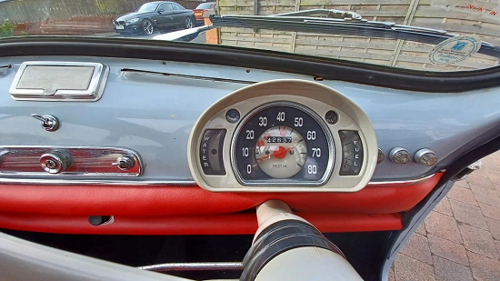ITALY’S MOST IMPORTANT POST-WAR CAR? THE FIAT 600D
05 June 2025
John Stock’s 1964 Fiat 600D is not a rare example of a RHD UK-market car, but one of the most important cars in the history of the Italian motor industry. Here are 25 facts about this remarkable motor car.
1. Fiat began work on Project Tipo 100, their replacement for the 500 Topolino, in 1946.
2. On the 1st of August 1951 Fiat’s directorship issued a directive: “The speed must not be less than 85 km/h, and the weight will be around 450 kg, of which 250 for the bodywork and 200 for the mechanical part. The capacity is four people”.

3. Dante Giacosa, Fiat’s engineering manager, favoured unitary construction - a ‘first’ for the company. He reflected: “My concerns lay in building a light and economical machine, with a pleasing exterior and spacious interior. Likewise, the mechanics had to be simple, and the engine located in an accessible location”.
4. By 1951, Fiat’s management had to choose between front-wheel-drive or “all at the rear”.
5. Between 1952 and 1954, Fiat built five Tipo 100 prototypes.
6. The Tipo 100 further boasted all-independent suspension, and an engine longitudinally mounted behind the transmission to save space.
7. The radiator and cooling fan were located on the side of the engine. Giacosa explained: “I originally planned a radiator at the front. Then I opted for an air intake; but naturally, I found that this slowed the vehicle down. Anyway, we prefer to leave it as is, since if the car is in optimal condition, it runs without overheating. This requires a tight fan belt and no scaling in the radiator”.
8. The 600 debuted on the 9th of March 1955 at the Geneva Motor Show as Fiat’s first rear engine car.
9. The 20th of April 1955 marked the 600’s Italian launch at the Turin Motor Show.
10. Fiat also arranged for a parade of 600s through the streets of Turin.
11. S.A.V.A. hire purchase meant a 600 buyer could pay 590,000 lire (the equivalent of £295) in only 24 instalments.
12. At that time, 960,000 lire was regarded as a very good annual wage for an Italian worker.
13. The 600 was cheaper than the outgoing 500C Belvedere, which cost 625,000 lire.

14. Within a few months, 600 delivery times were over a year.
15. 600 buyers could even specify pigskin luggage specially designed for the latest Fiat.
16. The top speed was 59 mph.
17. In 1955, Zastava of the former Yugoslavia began making the 600 under licence at their Kragujevac plant, building the last example as recently as 1985.
18. Autocar described the Fiat 600 in one of the first English-language road tests as “one of those original designs which creates another milestone in the history of motoring.”
19. In 1957, SEAT - Sociedad Española de Automóviles de Turismo – introduced their version of the 600. By the late 1960s, they constituted half of the cars on Spanish roads
20. Fiat upgraded the 600 as the 600D with a 767cc engine in place of the earlier 633cc unit, a combined ignition starter, a modified bonnet lid, and front quarter lights in 1960.
21. By 1961, production exceeded one million.
22. John’s 600D is one of the last with rear-hinged doors, as Fiat used forward hinges from May 1964 onwards.
23. In 1964, the Fiat 600D cost £469, compared with £493 for a Mini Super Mini, £532 for a Hillman Imp De Luxe, or £552 for a Daf Daffodil.
24. The last of 2,695,197 600s left the Turin works on the 18th of May 1969.
25. SEAT 600 production ceased in 1973. The last model wore a garland stating, “You were born a prince but die a king”.
With thanks to John Stock for his time.
With thanks to John Stock for the permission to use the images in this blog - https://www.carandclassic.com/l/C1852254
